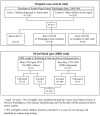Newborn screening archives as a specimen source for epidemiologic studies: feasibility and potential for bias
- PMID: 18063239
- PMCID: PMC2190083
- DOI: 10.1016/j.annepidem.2007.06.002
Newborn screening archives as a specimen source for epidemiologic studies: feasibility and potential for bias
Abstract
Purpose: To evaluate the feasibility of obtaining dried blood spots (DBS) from newborn screening archives for subjects in epidemiologic studies and using these specimens for genotyping, and to evaluate the potential for bias in their use.
Methods: We attempted to locate DBS at Washington State's archives for 230 participants in a previous case-control study of childhood cancer, who were born 1978-1990. We compared characteristics of children for whom we did and did not locate specimens and attempted genetic polymorphism analyses (11 polymorphisms, 82-480 bp amplicons).
Results: We retrieved specimens for 203 (88%) children, including 199 (94%) born in months when a DBS catalog was available. Among the latter, the proportion with specimens located varied by birth place (e.g., hospital, home), maternal education, and prenatal smoking, but did not vary significantly by race/ethnicity. All genotyping assays were completed for all specimens, and among controls genotype distributions were in Hardy-Weinberg equilibrium and similar to previous reports.
Conclusions: Newborn screening archives have potential to provide specimens for epidemiologic studies conducting genotyping and perhaps other assays, but the possibility that reliance on these resources could bias risk estimates must be considered.
Figures
Similar articles
-
Folic acid supplementation and malaria susceptibility and severity among people taking antifolate antimalarial drugs in endemic areas.Cochrane Database Syst Rev. 2022 Feb 1;2(2022):CD014217. doi: 10.1002/14651858.CD014217. Cochrane Database Syst Rev. 2022. PMID: 36321557 Free PMC article.
-
Storage and use of residual dried blood spots from state newborn screening programs.J Pediatr. 2006 May;148(5):618-22. doi: 10.1016/j.jpeds.2005.12.053. J Pediatr. 2006. PMID: 16737872
-
Prenatal Education of Parents About Newborn Screening and Residual Dried Blood Spots: A Randomized Clinical Trial.JAMA Pediatr. 2016 Jun 1;170(6):543-9. doi: 10.1001/jamapediatrics.2015.4850. JAMA Pediatr. 2016. PMID: 27043416 Free PMC article. Clinical Trial.
-
The feasibility and cost of neonatal screening for prenatal alcohol exposure by measuring phosphatidylethanol in dried blood spots.Alcohol Clin Exp Res. 2013 Jun;37(6):1008-15. doi: 10.1111/acer.12045. Epub 2013 Feb 19. Alcohol Clin Exp Res. 2013. PMID: 23421919 Free PMC article.
-
Use of filter paper for the collection and analysis of human whole blood specimens.J Nutr. 2001 May;131(5):1631S-6S. doi: 10.1093/jn/131.5.1631S. J Nutr. 2001. PMID: 11340130 Review.
Cited by
-
Childhood brain tumors and maternal cured meat consumption in pregnancy: differential effect by glutathione S-transferases.Cancer Epidemiol Biomarkers Prev. 2011 Nov;20(11):2413-9. doi: 10.1158/1055-9965.EPI-11-0196. Epub 2011 Sep 13. Cancer Epidemiol Biomarkers Prev. 2011. PMID: 21914837 Free PMC article.
-
Feasibility of neonatal dried blood spot retrieval amid evolving state policies (2009-2010): a Children's Oncology Group study.Paediatr Perinat Epidemiol. 2011 Nov;25(6):549-58. doi: 10.1111/j.1365-3016.2011.01228.x. Epub 2011 Aug 10. Paediatr Perinat Epidemiol. 2011. PMID: 21980944 Free PMC article.
-
Neonatal vitamin D and childhood brain tumor risk.Int J Cancer. 2015 May 15;136(10):2481-5. doi: 10.1002/ijc.29291. Epub 2014 Nov 9. Int J Cancer. 2015. PMID: 25348494 Free PMC article.
-
2020 APHRS/HRS expert consensus statement on the investigation of decedents with sudden unexplained death and patients with sudden cardiac arrest, and of their families.J Arrhythm. 2021 Apr 8;37(3):481-534. doi: 10.1002/joa3.12449. eCollection 2021 Jun. J Arrhythm. 2021. PMID: 34141003 Free PMC article.
-
Childhood brain tumors, residential insecticide exposure, and pesticide metabolism genes.Environ Health Perspect. 2010 Jan;118(1):144-9. doi: 10.1289/ehp.0901226. Environ Health Perspect. 2010. PMID: 20056567 Free PMC article.
References
-
- Barnette P, Scholl R, Blandford M, Ballard L, Tsodikov A, Magee J, et al. High-throughput detection of glutathione s-transferase polymorphic alleles in a pediatric cancer population. Cancer Epidemiol Biomarkers Prev. 2004;13:304–13. - PubMed
Publication types
MeSH terms
Grants and funding
LinkOut - more resources
Full Text Sources
Medical


